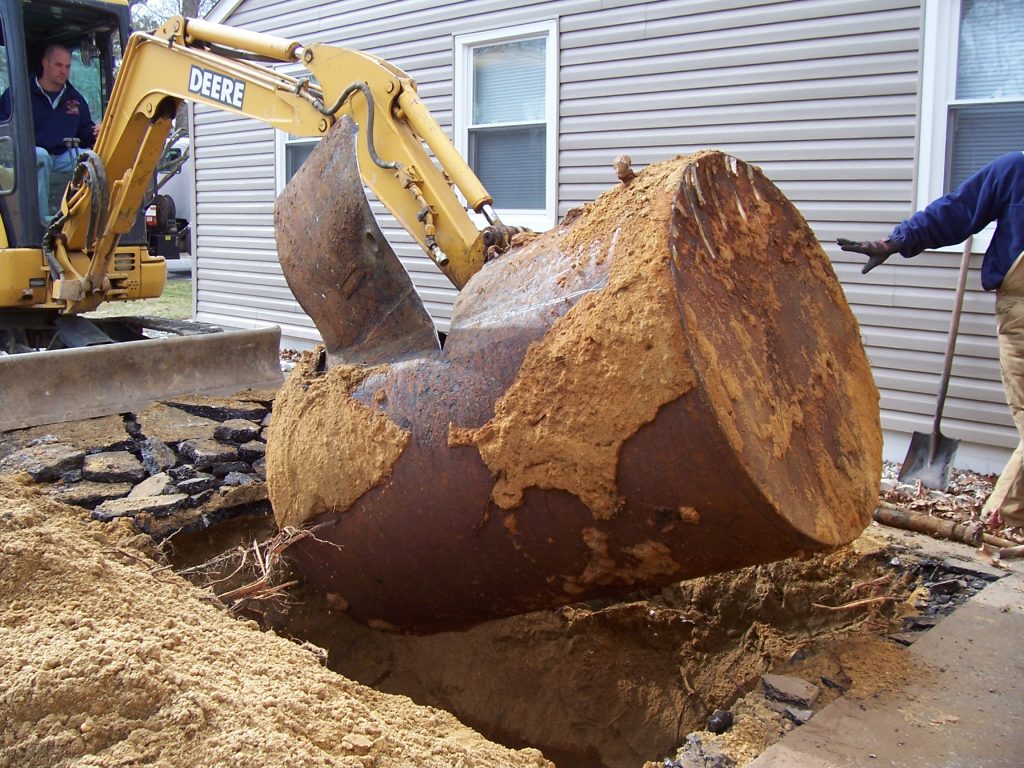Oil and gas storage tanks are used to store a variety of oils, fuels, and other liquids. These tanks can be found underground or aboveground at many homes and businesses. Underground, the tanks are buried deep enough to avoid accidental contact with people. Aboveground, safety fences typically secure the tanks. The process and costs of removing underground oil storage tanks vary based on location and conditions. Here are some things you should know about removing underground oil storage tanks at your home or business.
Locating your oil tanks.
Depending on how old your oil tanks are, there may be well-kept records of their installation and location from the builder or with your local municipality. However, older tanks may not be well documented and require an environmental company with special tools, such as a magnetometer, to sweep your property for existing tanks. Depending on the age and condition of the tank, your environmental company may recommend soil testing to ensure that the tank did not leak contaminants into the nearby soil.
Understanding the removal process.
Removing underground oil storage tanks for the first time will take patience and planning. This process may take several weeks to complete depending on the complexity of your project. The technique for removing oil tanks will vary depending on their position (e.g., above ground or underground) and budget. At the highest level, the removal of oil tanks may require permits and other planning permissions – your environmental company will be able to assist you through these processes and inform you of any regulatory compliance before working. Leaking tanks must have special consideration taken to ensure that no further environmental damage is done. Please make sure the company you choose is certified and licensed within the state the tank is being removed.
Knowing the Costs.
Removing underground oil storage tanks can be a significant investment and, therefore, a considerable burden on your budget. According to the Environmental Protection Agency (EPA), the average cost to remove a leaking 250-gallon underground storage tank is $25,000 to $80,000 (for your knowledge, the tank sizes are typically between 300 and 1,000 for residential properties). Fortunately, several programs can help you recoup expenses, reducing the financial stress that you may be experiencing. Several states offer grants and similar for businesses with leaking oil tanks, and many environmental companies work with financing companies to help alleviate financial stress.
Risks of Leaving Old Storage Tanks.
If you want to leave an old fuel storage tank at your home or business (which is not recommended), you should consider the following:Size – If a tank is located near the ground or close to a window or sidewalk, it could create a safety hazard.Age – if the tank is old, it could be close to failure and may cause further damage to the area.Location – You should always know any nearby utilities, including electricity, natural gas, and telephone lines. Severely damaged tanks may cause damage to nearby utilities.An oil tank left to rot may cause a more significant and more expensive environmental concern than just removing it outright.
Faulty and Leaking Tanks.
Up to 7% of all the oil pumped in the United States is stored in underground storage tanks. Stored oil can be highly volatile, especially if it has been sitting undisturbed for years. Oil may release vapors if improperly treated. If you suspect your underground oil storage tank is leaking, do not assume it is a safe location for your family. Make an emergency plan for yourself and your family in the event an accident occurs. Oil storage tank removal requires specialized equipment and proper training. Removal teams must know how to deal with hazardous material, and in many states, a Department of Environmental Protection certification is required for waste oil removal.
Environmental Concern
Some of the main concerns regarding the lack of maintenance or removal of underground oil storage tanks involve leaking oil or fuel into the ground. Leaking underground oil storage tanks comes with severe environmental impacts. Water contamination can occur from hydrocarbons that seep through the storage tank. This can cause groundwater to become contaminated and dangerous for drinking – acidifying water caused by oil leaks can make it difficult or impossible to use nearby water supplies.In addition to contaminating groundwater, leaking oil tanks can cause a subsurface oil spill, which can be a huge mess and even more costly to remediate. Heating oil is lighter than water, which allows it to flow on top of the groundwater to nearby receptors, i.e., neighboring properties, basements, or drinking water wells.
Conclusion
Removing or upkeeping oil storage tanks is an essential maintenance task for property owners. You should manage your business or home tank to reduce its exposure to fuel spills and other spills that could cause damage to vehicles or property. Environmental companies such as Meridian Environmental can identify which tanks are most prone to leaks and educate you on maintenance steps to minimize the risks.




